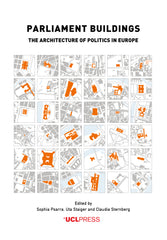Open access reading for World Architecture Day
It's World Architecture Day! Celebrate with us by delving into the latest open access books on architecture theory and practice.
As political polarisation undermines confidence in the shared values and established constitutional orders of many nations, it is imperative that we explore how parliaments are to stay relevant and accessible to the citizens whom they serve. The rise of modern democracies is thought to have found physical expression in the staged unity of the parliamentary seating plan. However, the built forms alone cannot give sufficient testimony to the exercise of power in political life.
Parliament Buildings edited by Sophia Psarra, Uta Staiger, and Claudia Sternberg, brings together architecture, history, art history, history of political thought, sociology, behavioural psychology, anthropology and political science to raise a host of challenging questions. How do parliament buildings  give physical form to norms and practices, to behaviours, rituals, identities and imaginaries? How are their spatial forms influenced by the political cultures they accommodate? What kinds of histories, politics and morphologies do the diverse European parliaments share, and how do their political trajectories intersect?
give physical form to norms and practices, to behaviours, rituals, identities and imaginaries? How are their spatial forms influenced by the political cultures they accommodate? What kinds of histories, politics and morphologies do the diverse European parliaments share, and how do their political trajectories intersect?
This volume offers an eclectic exploration of the complex nexus between architecture and politics in Europe. Including contributions from architects who have designed or remodelled four parliament buildings in Europe, it provides the first comparative, multi-disciplinary study of parliament buildings across Europe and across history.
Seen through the distilling lens of the architectural model, Lisa Moffitt's Architecture’s Model Environments is a novel and far-reaching exploration of the many dialogues buildings have with their environmental surroundings. Expanding on histories of building technology, the book sheds
new light on how physical models conventionally understood as engineering experimentation devices enable architectural design speculation.
The book begins with a catalogue of ten original model prototypes – of wind tunnels, water tables and filling boxes – and is the first of its kind to establish an architectural approach to fabricating such environmental models. Subsequent chapters feature three precedent models that have been largely overlooked within the wider oeuvres of their authors: French polymath Étienne-Jules Marey’s 1900-2 wind tunnels, Hungarian-American architects Victor and Aladár Olgyay’s 1955-63 thermoheliodon, and Scottish chemist and building ventilation expert David Boswell ‘The Ventilator’ Reid’s 1844 test tube convection experiments.
Moving between historic moments and the present day, between case studies and original prototypes, the book reveals the potent ability for models, as both physical artefacts and mental ideals, to reflect prevailing cultural views about the world and to even reshape those views. Fundamentally, Architecture’s Model Environments illustrates how environmental models reveal design insights across scales from the seam (that leaks) to the body (that feels) to the building (that mediates) to the world (that immerses).
 representative or social functions, we argue for the historical legitimacy of creative craft skill as a primary agent in architectural production. However, in contrast to the connoisseurial and developmental perspectives of the past, this book is concerned with how surfaces were designed, achieved and experienced.
representative or social functions, we argue for the historical legitimacy of creative craft skill as a primary agent in architectural production. However, in contrast to the connoisseurial and developmental perspectives of the past, this book is concerned with how surfaces were designed, achieved and experienced.
